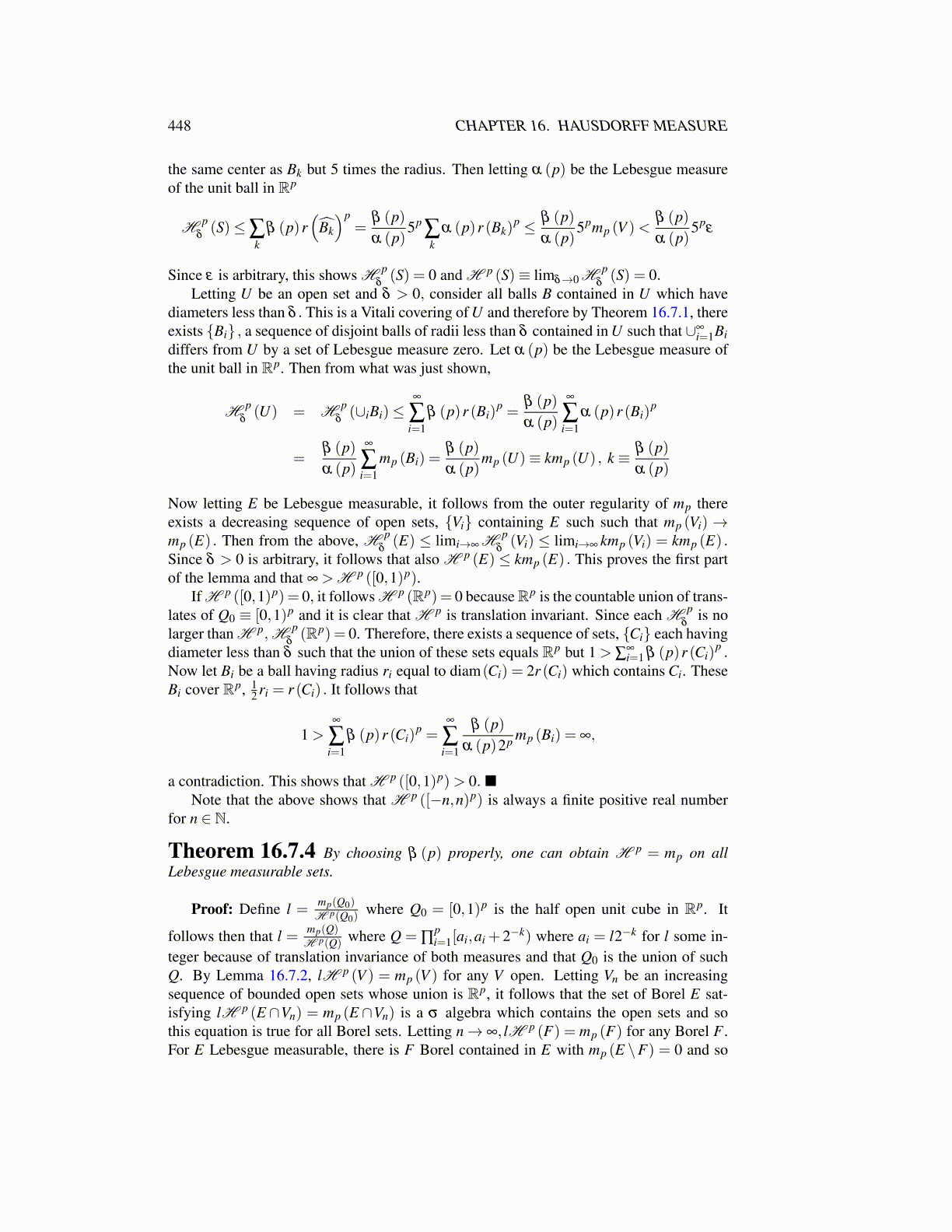
448 CHAPTER 16. HAUSDORFF MEASURE
the same center as Bk but 5 times the radius. Then letting α (p) be the Lebesgue measureof the unit ball in Rp
H pδ(S)≤∑
kβ (p)r
(B̂k
)p=
β (p)α (p)
5p∑k
α (p)r (Bk)p ≤ β (p)
α (p)5pmp (V )<
β (p)α (p)
5pε
Since ε is arbitrary, this shows H pδ(S) = 0 and H p (S)≡ limδ→0 H p
δ(S) = 0.
Letting U be an open set and δ > 0, consider all balls B contained in U which havediameters less than δ . This is a Vitali covering of U and therefore by Theorem 16.7.1, thereexists {Bi} , a sequence of disjoint balls of radii less than δ contained in U such that ∪∞
i=1Bidiffers from U by a set of Lebesgue measure zero. Let α (p) be the Lebesgue measure ofthe unit ball in Rp. Then from what was just shown,
H pδ(U) = H p
δ(∪iBi)≤
∞
∑i=1
β (p)r (Bi)p =
β (p)α (p)
∞
∑i=1
α (p)r (Bi)p
=β (p)α (p)
∞
∑i=1
mp (Bi) =β (p)α (p)
mp (U)≡ kmp (U) , k ≡ β (p)α (p)
Now letting E be Lebesgue measurable, it follows from the outer regularity of mp thereexists a decreasing sequence of open sets, {Vi} containing E such such that mp (Vi)→mp (E) . Then from the above, H p
δ(E) ≤ limi→∞ H p
δ(Vi) ≤ limi→∞ kmp (Vi) = kmp (E) .
Since δ > 0 is arbitrary, it follows that also H p (E) ≤ kmp (E) . This proves the first partof the lemma and that ∞ > H p ([0,1)p).
If H p ([0,1)p)= 0, it follows H p (Rp)= 0 becauseRp is the countable union of trans-lates of Q0 ≡ [0,1)p and it is clear that H p is translation invariant. Since each H p
δis no
larger than H p, H pδ(Rp) = 0. Therefore, there exists a sequence of sets, {Ci} each having
diameter less than δ such that the union of these sets equals Rp but 1 > ∑∞i=1 β (p)r (Ci)
p .Now let Bi be a ball having radius ri equal to diam(Ci) = 2r (Ci) which contains Ci. TheseBi cover Rp, 1
2 ri = r (Ci) . It follows that
1 >∞
∑i=1
β (p)r (Ci)p =
∞
∑i=1
β (p)α (p)2p mp (Bi) = ∞,
a contradiction. This shows that H p ([0,1)p)> 0. ■Note that the above shows that H p ([−n,n)p) is always a finite positive real number
for n ∈ N.
Theorem 16.7.4 By choosing β (p) properly, one can obtain H p = mp on allLebesgue measurable sets.
Proof: Define l = mp(Q0)H p(Q0)
where Q0 = [0,1)p is the half open unit cube in Rp. It
follows then that l = mp(Q)H p(Q) where Q = ∏
pi=1[ai,ai + 2−k) where ai = l2−k for l some in-
teger because of translation invariance of both measures and that Q0 is the union of suchQ. By Lemma 16.7.2, lH p (V ) = mp (V ) for any V open. Letting Vn be an increasingsequence of bounded open sets whose union is Rp, it follows that the set of Borel E sat-isfying lH p (E ∩Vn) = mp (E ∩Vn) is a σ algebra which contains the open sets and sothis equation is true for all Borel sets. Letting n→ ∞, lH p (F) = mp (F) for any Borel F .For E Lebesgue measurable, there is F Borel contained in E with mp (E \F) = 0 and so